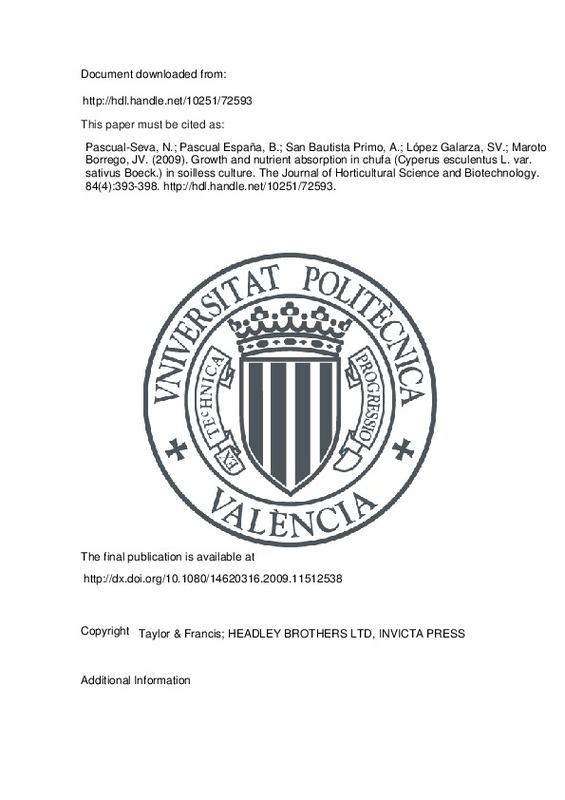JavaScript is disabled for your browser. Some features of this site may not work without it.
Buscar en RiuNet
Listar
Mi cuenta
Estadísticas
Ayuda RiuNet
Admin. UPV
Growth and nutrient absorption in chufa (Cyperus esculentus L. var. sativus Boeck.) in soilless culture
Mostrar el registro sencillo del ítem
Ficheros en el ítem
| dc.contributor.author | Pascual-Seva, Nuria
|
es_ES |
| dc.contributor.author | Pascual España, Bernardo
|
es_ES |
| dc.contributor.author | San Bautista Primo, Alberto
|
es_ES |
| dc.contributor.author | López Galarza, Salvador Vicente
|
es_ES |
| dc.contributor.author | Maroto Borrego, José Vicente
|
es_ES |
| dc.date.accessioned | 2016-10-21T11:05:14Z | |
| dc.date.available | 2016-10-21T11:05:14Z | |
| dc.date.issued | 2009-07 | |
| dc.identifier.issn | 1462-0316 | |
| dc.identifier.uri | http://hdl.handle.net/10251/72593 | |
| dc.description.abstract | [EN] The efficiency of fertilisation in agriculture is often low, and if one knows the nutrient uptake rate, efficiency can be improved by synchronizing nutrient supply with nutrient demand. Growth and the time-course of nutrient accumulation and its partitioning between the different organs of chufa (Cyperus esculentus L. var. sativus Boeck.), an under-exploited cultivated plant, were examined. The study was conducted in soilless, open-field conditions, at a planting density equivalent to 55,500 plants ha-1 in three consecutive seasons. Plants were sampled, fractionated into leaves, roots, and tubers, then dried and weighed. Their macronutrient contents were analysed fortnightly. On average, the yield was 5.0 kg fresh weight tuber m-2 . Growth of the whole plant until 90 d after planting obeys an exponential function of time; the relative growth rate (RGR) for this period was determined. The highest N and K concentrations were recorded in leaves, and the highest P, Ca and Mg concentrations were found in roots. The highest accumulations of N and P were found in tubers, and of K and Ca in leaves. Nitrogen had the highest nutrient accumulation (58.3 g m-2 ) as well as the highest specific uptake rate. | es_ES |
| dc.description.sponsorship | This study was funded by the Consejo de Denominacion de Origen Chufa de Valencia, Spain. The authors thank the agricultural engineers, Juan Andres and Ramon Ballester, for assisting with the previous experiments, and Debra Westall for revising the manuscript. | |
| dc.language | Inglés | es_ES |
| dc.publisher | Taylor & Francis | es_ES |
| dc.publisher | HEADLEY BROTHERS LTD, INVICTA PRESS | es_ES |
| dc.relation.ispartof | The Journal of Horticultural Science and Biotechnology | es_ES |
| dc.rights | Reserva de todos los derechos | es_ES |
| dc.subject | Cultivar | es_ES |
| dc.subject | Crop | es_ES |
| dc.subject | Cyperus esculentus L. var. sativus Boeck. | es_ES |
| dc.subject | Tiger nut sedge | es_ES |
| dc.subject.classification | PRODUCCION VEGETAL | es_ES |
| dc.title | Growth and nutrient absorption in chufa (Cyperus esculentus L. var. sativus Boeck.) in soilless culture | es_ES |
| dc.type | Artículo | es_ES |
| dc.identifier.doi | 10.1080/14620316.2009.11512538 | |
| dc.rights.accessRights | Abierto | es_ES |
| dc.contributor.affiliation | Universitat Politècnica de València. Departamento de Producción Vegetal - Departament de Producció Vegetal | es_ES |
| dc.description.bibliographicCitation | Pascual-Seva, N.; Pascual España, B.; San Bautista Primo, A.; López Galarza, SV.; Maroto Borrego, JV. (2009). Growth and nutrient absorption in chufa (Cyperus esculentus L. var. sativus Boeck.) in soilless culture. The Journal of Horticultural Science and Biotechnology. 84(4):393-398. doi:10.1080/14620316.2009.11512538 | es_ES |
| dc.description.accrualMethod | S | es_ES |
| dc.relation.publisherversion | http://dx.doi.org/10.1080/14620316.2009.11512538 | es_ES |
| dc.description.upvformatpinicio | 393 | es_ES |
| dc.description.upvformatpfin | 398 | es_ES |
| dc.type.version | info:eu-repo/semantics/publishedVersion | es_ES |
| dc.description.volume | 84 | es_ES |
| dc.description.issue | 4 | es_ES |
| dc.relation.senia | 36321 | es_ES |
| dc.contributor.funder | Consejo Regulador de la Denominación de Origen Chufa de Valencia | |
| dc.description.references | Alegría, A. and Farré, R. (2003). Horchata and health: nutritional and dietetic aspects. In:Conference on Chufa and Horchata, Tradition and Health.(In Spanish). Fundación Valenciana de Estudios Avanzados, Valencia, Spain. 55–70. | es_ES |
| dc.description.references | Andrés, J. (2006).Study of Nutrition, Principal Macronutrients Accumulation Rates, and Yield of Chufa(Cyperus esculentus L.var.sativusBoeck.)Growing in Perlite.(In Spanish). M.Sc. Thesis. Universidad Politécnica de Valencia, Valencia, Spain. 89 pp. | es_ES |
| dc.description.references | A.O.A.C. (1990).Official Methods of Analysis.5th Edition. Association of Official Analytical Chemists Inc., Arlington, VA, USA. 40–42. | es_ES |
| dc.description.references | Ballester, R. (2006).Influence of the Irrigation Frequency and Management in Nutrition, Growth, and Yield of Chufa(Cyperus esculentus L.var.sativusBoeck.). (In Spanish). M.Sc. Thesis. Universidad Politécnica de Valencia, Valencia, Spain. 76 pp. | es_ES |
| dc.description.references | Bixquert, M. (2003). Horchata and health: healthy properties and prevention of digestive diseases. In:Conference on Chufa and Horchata, Tradition and Health.(In Spanish). Fundación Valenciana de Estudios Avanzados, Valencia, Spain. 71–85. | es_ES |
| dc.description.references | Gardner, F. P., Pearce, R. B. and Mitchell, R. L. (1985).Physiology of Crop Plants.Iowa State University Press, Ames, IA, USA. 187–208. | es_ES |
| dc.description.references | Maynard, D. N. and Hochmuth, G. J. (1997).Knott’s Handbook forVegetable Growers.John Wiley & Sons Inc., NY, USA. 45–218. | es_ES |
| dc.description.references | Pascual, B., Maroto, J. V., López-Galarza, S., Alagarda, J. and Castell-Zeising, V. (1997).Studies Carried out in Chufa Cultivation.(In Spanish). Generalitat Valenciana, Conselleria de Agricultura, Pesca y Alimentación, Valencia, Spain. 95 pp. | es_ES |
| dc.description.references | Sas (1993).SAS/STAT®User’s Guide.Version 6. 2nd Edition. SAS Institute Inc., Cary, NC, USA. 1022 pp. | es_ES |
| dc.description.references | Ter Borg, S. J. and Schippers, P. (1992). Distribution of varieties ofCyperus esculentusL. (yellow nutsedge) and their possible migration in Europe.9thInternational Symposium on the Biology of Weeds. Annals of the Symposium.417–425. | es_ES |







![[Cerrado]](/themes/UPV/images/candado.png)

